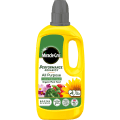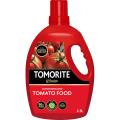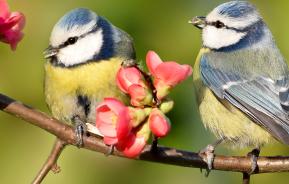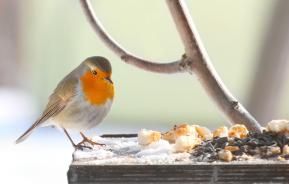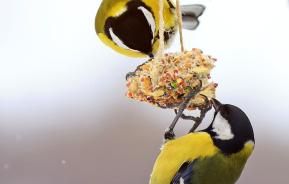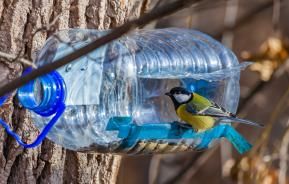The species of bird that you want to attract is important in deciding which nest box will be best for your garden and where to position it, as most have different requirements, especially when it comes to looking after nestlings.
All nest boxes should:
- Be a suitable size for their intended inhabitants.
- Have the correct type and size of entrance (open fronted or small hole).
- Be protected from strong wind, rain and sunlight.
- Have a removable or hinged lid to allow easier access for cleaning and maintenance.
- Be placed in a location with protection from predators.
Types of nest boxes
There are two main types of bird nest boxes which are suitable for different species of birds. The first is an open fronted nest box and the second is a small holed nest box. Both of these will require siting in slightly different ways.
Siting an open front nest box
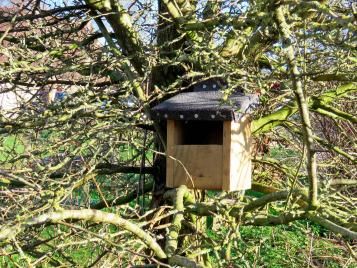
This type of nest box is normally preferred by Robins, Wrens and Pied Wagtails. They are best positioned 1-2m off the ground and can be attached to a wall, fence or tree that has good planting like shrubs and creepers growing around it, allowing cover for visiting birds. Larger versions of these nest boxes can sometimes be used by blackbirds also.
Siting a small hole nest box
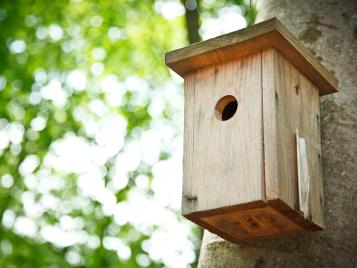
This is the most popular type of nest box as there are many variations available to attract different species of bird. There are two main factors to consider for a small holed nest box; the size of entrance hole and the height it needs to be placed. This will determine which birds will visit the nest box and make their home inside.
For most birds the best height to place the nest box is between 2-4m, attached securely to a wall, fence or tree, to ensure they’re out of reach from predators. Entrance holes with a diameter of 25mm are suitable for blue, coal and marsh tits, whilst a slightly larger entrance of 28mm will attract tree sparrows and great tits. Normally the largest entrance of 32mm will be good for bigger species such as house sparrows, nuthatches and woodpeckers.
Direction of nest box
The recommended direction to face a nest box is between north and east, as this will provide natural protection from direct sunlight, wind and rain, creating a more suitable and safe environment for growing birds. The box can also be tilted marginally forward to allow any rain to run clear of the entrance.
When to site a nest box
Birds start looking for possible places to store food and to roost in Winter, which they usually return to in Spring for nesting. So having your home for them ready in late Autumn, or early Winter, will allow plenty of time for the birds to get settled. Although it’s never too early or too late to put one up, there will always be opportunities for it to be used later.
Essentials of siting a nest box
- Make sure there is a direct flight path to the entrance of the nest box. Keeping it clear of obstructions will make it easier for birds to find the nest box and allow them to gain easy access in times of need.
- Avoid placing nest boxes too near to bird feeders and bird baths, as high levels of activity from visiting birds will cause disruption to established nests and may even lead to it being abandoned.
- Most species of bird are territorial, so having too many nest boxes in one area can cause problems. Try to distribute them evenly around the garden, ensuring there are sufficient food sources availablefor each one.
- When attaching a nest box to a tree, try not to use nails or other materials that will rust and cause damage to the tree. An alternative is to use an adjustable strap or galvanized wire.
- Make sure there are perches and areas of foliage for cover nearby. Nest boxes with a perch below the entrance can assist predators rather than the birds, so they are not recommended.
- If the nest box has not been inhabited for two years or more, try moving it to a new location. If still no luck, keep experimenting with different locations until you get success!
Nest boxes for owls and woodpeckers
As birds come in many different sizes and shapes, not all boxes are right for certain birds. Woodpeckers and owls are great examples of birds that require differently placed nest boxes for them to be attracted. The main difference is the height of the box. For these birds you will need to site the nest box between 3-5m off the ground, ideally against a tree with the larger surface facing the tree.
It is important that you have a clear flight path to the box and that you can access it easily in case the young fall out and need to be placed back in the box.
As well as putting up nest boxes and feeders to attract birds don’t forget you can grow plants that will provide not only shelter but food and nesting materials. Try growing a mixture of shrubs to provide these 3 essentials. They can be planted directly in the ground or in containers using a good peat free compost such as Miracle-Gro Peat Free Rose, Tree & Shrub Compost.





